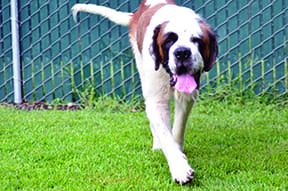I have long coveted an Irish Wolfhound. Commanding in appearance, they are known for being easygoing and gentle by nature, with a rakish air, courtesy of the wiry coat and bewhiskered face, for which I am a total sucker. This breed is one of several known as “Giants” – for good reason. Weighing in at 100-plus pounds, standing nearly 36 inches at the shoulder, they are impressively large. Others in this class include the Great Dane, Great Pyrenees, Newfoundland, Leonberger, English Mastiff, Neapolitan Mastiff, and others that exceed 100 pounds.
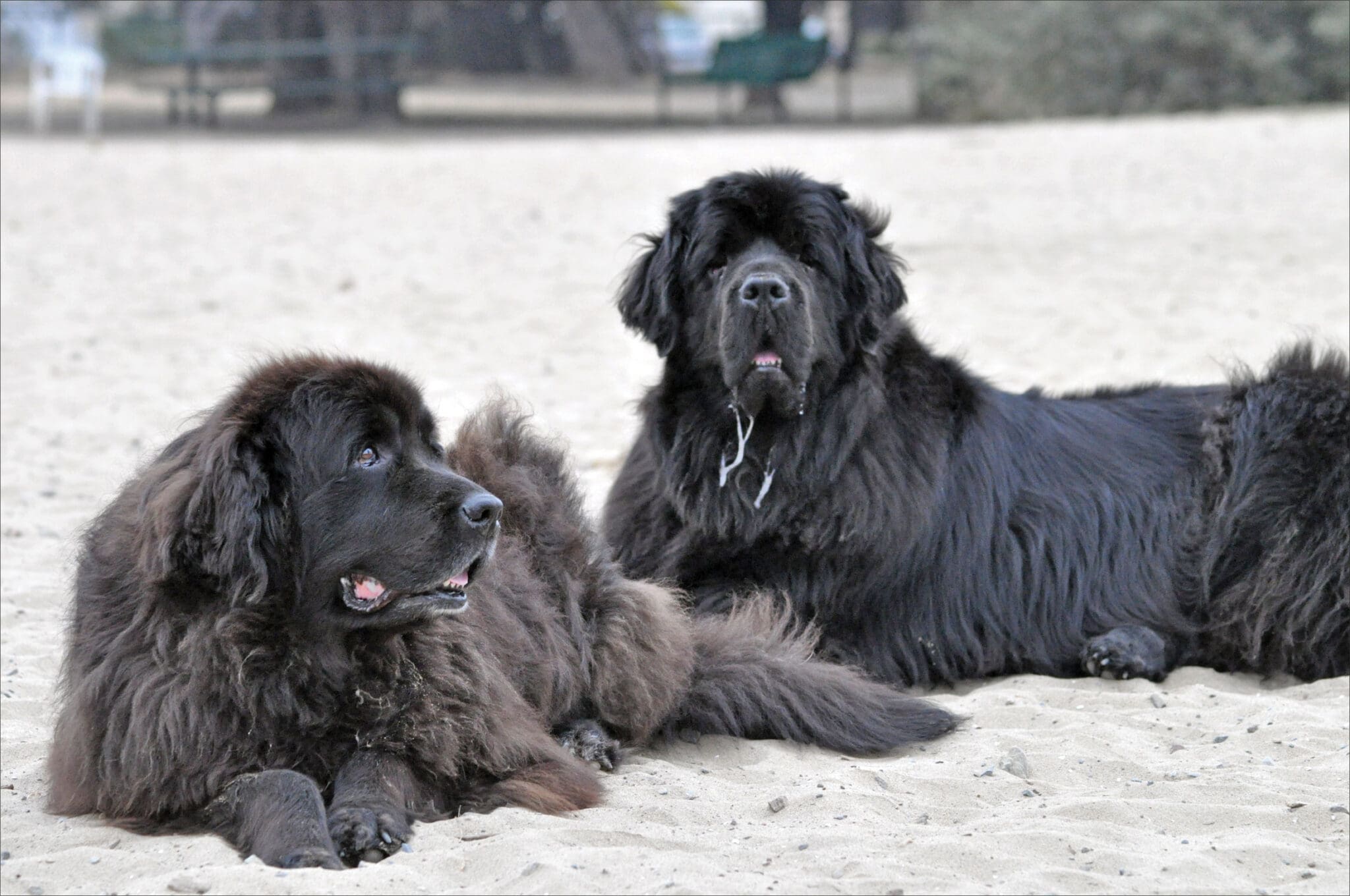
288
Many years ago, my love affair with large dogs (I once shared my life with a St. Bernard) fell victim to the realities of space and convenience. When adding a fifth dog to the group, we opted for a Pomeranian. While I still admire the dogs at the huge end of the size continuum, the largest dog in our current pack of five is our 45-pound Australian Shepherd, Missy. In fact, if you add all five of their weights together you would barely come up with enough poundage for one giant dog. Every time I find myself drawn to an extra-large canine, a small voice in the back of my head reminds me of all the challenges that accompany a dog who can look you squarely in the eye while he’s standing on all fours.
Size Matters
What are the challenges of big-dog ownership? For starters, everything about them is big, from their appetites (and by-products thereof) to the crates, collars, and other training equipment that they use, as well as the toys they play with. Pet supply companies offer giant-sized Kongs, tennis balls, tug toys, and just about every other canine accessory you can think of. They know there’s a “big” market out there.
Vet bills are bigger, too. Everything from topical flea and tick products to drugs to treat illnesses and modify behavior cost more – because big dogs need bigger doses. Surgeries are more expensive too; most are charged at least in part by the dog’s weight because larger dogs generally need higher doses of anesthesia drugs.
Even finding a place to live can be more of a challenge for big-dog humans. Many landlords and hotels, if they allow dogs at all, accept pets who are 25 pounds or less. The next socially acceptable size-increment seems to be around 70 to 75 pounds. Much bigger than that, and non-dog people tend to think you really are some kind of serious dog-nut, to share your life and home with a dog who outweighs many of the family members. Additionally, much to the distress of big-dog humans, many of the giant breeds are listed on insurance company “do not insure” lists, making it difficult at best, impossible at worst, to find homeowner’s or renter’s insurance.
Finally, sadly, many of the giant breeds tend to have short life spans. A 10-year-old Great Dane is pretty ancient, and many owners prepare their farewells to 7- and 8-year-old Danes. Meanwhile, lots of 10-year-old small dogs are still in the prime of life and their humans look forward to 5 to 10 more years of canine companionship.
The daunting size of these dogs can, without a doubt, present their owners with a host of training and management challenges not encountered by those who share their lives with more moderately sized dogs. It requires a lot of thought and effort for a Beagle to be successful at counter-surfing. A Great Dane merely needs to walk past a food-laden dining room table and temptation is right under his nose. My Dodge Caravan can easily accommodate crates for all five of our dogs, ranging in size from 10 to 45 pounds. It would take a small motor home to accommodate crates for five St. Bernards!
Everything you’ve heard about training and management is massively magnified for your big dog. Don’t even think about putting off training class until your wee one is six months old and is dragging you down the sidewalk. Good manners training is mandatory for these giant canines starting at the age of eight weeks. Their forbidding size demands an early course in juvenile good manners; the sooner they are reinforced for appropriate behaviors, the less likely they are to engage in inappropriate ones.
Early socialization is equally vital. These are dogs who, if not well-socialized, have the ability to cause significant injury, even death, to another dog – or human. If they don’t learn to enjoy the company and attentions of others during that critical socialization window, which quickly closes after the young age of 14 weeks, they run a high risk of getting into big trouble. Add the genetically programmed guarding behavior of many of the giant breeds into the mix, and you have a recipe for disaster if your baby big dog doesn’t learn, early on, that the world is a wonderful place.
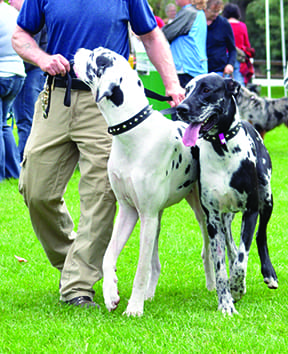
288
A poorly socialized, poorly trained large dog is a significant risk to the safety of the community. A well-socialized, well-trained dog will be able to turn on his protective behaviors if needed, but no matter his size, will be safe to have around your friends and family. A poorly socialized small dog makes the same sad statement about pet-owner irresponsibility as an unsocialized large dog, but is less of a risk to the community; a kamikaze Yorkie can do far less damage on his worst day than a scud missile Neapolitan Mastiff on a minor bender.
A Tall Training Challenge
There are a number of good manners behaviors that are particularly important to teach your large dog while she is still small. Pay special attention to these if you have a big dog.
Polite Greeting: Jumping on humans is rude behavior for any canine, and especially intolerable for a large dog. Avoid the temptation to pick her up and cuddle your giant pup. Cuddling teaches her that “up” is a very wonderful place to be, and reinforces her for behavior that you will regret when she reaches her adult size. Instead, designate a spot on the floor as “cuddle space,” and get down on her level to do snuggle time.
Reinforce her “Sit” as a greeting/default behavior so consistently and frequently that it’s the first thing that pops into her brain, even when she’s happy and excited to see you or your visitors. Insist that family members, visitors, and people on the street greet her only when she is sitting, and turn their backs or step away if she jumps up or bashes into them with her head or body.
Additionally, you can practice polite greeting with your pup secured on a tether and/or behind a barrier such as a baby gate or exercise pen, so you can step away from her if she tries to jump up or bulldoze into you. This will prevent her from getting reinforcement by having physical contact with you unless she earns that reward through her self-control.
Polite Leash Walking: If you do nothing else, you must teach your big dog to walk politely on leash. Without a doubt, she will be big and strong enough at maturity to drag even a large adult human off his feet. If you can’t take her out and about on leash under control, you probably won’t take her out. If you do, the two of you are likely to get into trouble. The keys to teaching good leash walking are: a high rate of reinforcement for being in position next to you (lots of clicks and treats); and very high-value treats, so that it’s more rewarding for your dog to pay attention to you than her surroundings.
Start by simply clicking and treating your dog for sitting by your side. When she will sit next to you for several seconds at a time, take one step, have her sit when you stop; click and treat. Repeat this until she automatically sits when you stop, then increase to two steps and stop. Gradually increase the number of steps you take, always having her sit by your side when you stop. When you are up to a dozen steps or so, start clicking and treating while you are still in motion. (Remember to always feed the treat to her when she is in position at your side. If you feed in front of you, you will teach her to block your path.)
If you’ve already missed out on teaching polite leash walking while your pup is small, consider using a front-clip control harness to maintain gentle control of your big dog while you retrain her leash behavior. (See “In Pursuit of a Loose Leash: Proper Use of No-Pull Harnesses,” WDJ October 2012.)
Say Please: A “say please” program teaches your dog that good things in life come to dogs who sit. This prevents her from learning that she can push people around by virtue of her sheer weight and size. You can initially train and ask for the sit behavior, but your ultimate goal is for your dog to offer sits without being asked.
If she is allowed on the furniture, she sits and waits to be invited, rather than just helping herself to the empty space on the sofa next to your visitor. Want to go outside? “Sit” makes the door open. Ready for dinner? “Sit” makes the dinner bowl descend to the floor. While you needn’t go so far as to require her to sit for everything good in her world, “sit” really is a delightful default good manners behavior that keeps your dog out of trouble.
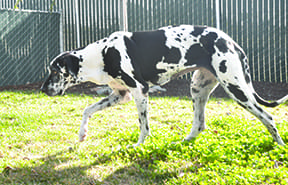
288
Settle: A big-dog lover myself, I don’t understand why some people don’t fully appreciate the joy of having a Newfoundland drool in their laps, but some just don’t! A big dog is still plenty accessible for the occasional pat on the head if she is lying at your visitor’s feet instead of panting in his face.
Teach your dog that “settle” (lying at the feet of humans) is a highly rewarded behavior. Give her attention and treats on a variable schedule (sometimes close together, sometimes with longer pauses in between) when she lies down quietly. Give your guests a container full of treats and instruct them to reward your dog on a random schedule, too. Be sure to ignore any demand behavior, such as whining or barking, so she learns that the only behavior that gets rewarded is a calm “settle.”
Leave It: It’s a fact. Giant breeds have easier access to food-bearing surfaces such as tables and kitchen counters. One chance encounter with a roast beef sandwich can turn a dog into a dedicated counter-surfer in an instant. In addition to managing your big dog so she never has the opportunity to learn to counter-surf, a well-installed “leave it” cue, which tells her to back away from whatever she is looking at, can avert disaster when she has that “Mine!” gleam in her eye and is closer to the holiday turkey than you are.
To teach “leave it,” show her a sturdy, non-crushable treat such as a cube of freeze-dried liver, say “Leave it!” and place it under your foot. Simply ignore her as she tries to chew or dig it out from under your foot. The instant she removes her attention from the hidden goodie, click and feed her a high-value treat from your hand. As long as she isn’t trying to get the cube, click and treat several times in a row.
When she starts to understand the zen of “get a treat by ignoring the treat,” expose the goodie on the floor by moving your foot slightly to the side. If she dives for it, just cover it back up with your foot and wait for her to ignore it again. Click and treat. Repeat until she makes no effort to obtain the exposed treat on the ground. Eventually your “leave it” cue will cause her to turn her attention away from a coveted object in anticipation of a high value treat from you.
Sharing With Others: Like so many other things, resource-guarding by a large dog can be infinitely more disastrous than the same behavior presented by her smaller counterparts. When your pup is small, teach her that having humans approach her when she is eating or otherwise occupied with a high-value possession makes even more great stuff happen. When she is eating from her food bowl, occasionally approach and drop a few exquisite goodies into it. Before long she will want people to be around when she is eating.
Do not succumb to the temptation to grab her food away from her, just because you can. Forcing her to give up her food can create food-bowl stress. You want to reassure her that your presence at her food bowl is not a threat, but rather an opportunity for more good stuff.
Caution: If you already have a serious resource guarding challenge with your dog, big or small, find a qualified positive reinforcement-based trainer/behavior specialist to help you modify this potentially dangerous behavior.
Go to Your Place: This behavior is especially helpful if you have guests who don’t appreciate super-sized canines. You can use luring, targeting, or shaping your dog to teach her “go to your spot” (a comfy bed placed a reasonable distance away, but where she can still be part of the social scene). If you use a portable bed or rug to mark her “spot,” you can take it with you – to the dining room during meals, the den for videos, even to the beach for a picnic and your friends’ houses when you and your big dog go visiting.
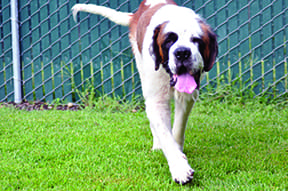
288
Trade: The last thing you want to do is get into an argument with a big dog over something she has in her mouth. Teach your dog to “Trade” by offering treats when she has a toy.
Most people make the mistake of only taking “forbidden objects” away from their dogs, which can teach the dog to resist, since she learns that she’ll never get it back. If you practice “Trade” as a regular training exercise with a “legal” toy or chew object, you can repeatedly return the object in question after your dog gives it up for a high-value treat. She learns that she gets two rewards – the first for giving up the valuable object, the second when she gets the valuable object back again. Then, if she occasionally has to give up an “illegal” object that you can’t return to her, it won’t outweigh the positive impact of all the two-reward trades you have done with her.
Remember not to take your dog’s willingness to trade for granted. My dogs will usually give up coveted objects on cue. In order to keep the positive association strong, I still reward them with a treat when I ask them to trade, even when they easily and voluntarily drop the object in question.
Bite Inhibition: Dogs bite. It’s a natural canine behavior. Chances are that at some time in your dog’s life, she may feel compelled to bite. If and when that happens, good bite inhibition could make the difference between a dent in the skin and plastic surgery. It could also determine whether your dog lives or dies, since dogs who bite and cause serious injury tend to not live long – especially big dogs who bite.
You can instill good bite inhibition in a pup by gradually diminishing the force of her bite rather than punishing all bites. A puppy naturally learns to control the force of her teeth through playing with her siblings. If she bites softly, without causing undue pain, the other puppies will keep playing with her. If she bites too hard, the pup she’s biting may yelp and run away, refusing to re-engage in play for a time.
You can do the same thing. If your giant puppy bites softly, continue playing with her. If she bites hard enough to cause pain, calmly say “Ouch!” or “Oops!” and walk away from her. (Don’t bother trying to imitate a puppy yelp. We usually fail miserably when we attempt to imitate canine vocal communication, and a yelp often arouses an excited puppy even more.) After a short time, begin playing with her again. She will learn to control her bite so that the fun can continue without interruption.
Be Positive
If you think it’s a good idea to force confrontations with your big dog, think again.
First, it’s not necessary, and second, the bigger the dog gets, the more likely you are to lose. In old-fashioned force-based training, owners were advised to dominate their dogs, and if the dogs fought back, to increase the level of human aggression until the dogs submitted. Dogs who refused to submit were labeled “vicious” and “incorrigible” and euthanized.
It takes two to fight. If you train with positive methods, you never set the dog up for conflict. Rather you set your dog up to succeed, and teach her to willingly and happily respond to your behavior requests because good things happen when she does.
Remember, dogs naturally growl to communicate that they are stressed by, uncomfortable with, or otherwise feel threatened by the presence of an aversive stimulus. Unfortunately, growling makes some humans feel so threatened that they feel compelled to punish and “dominate” the dog in some sort of misguided “show them who’s boss” display. If you respond to a fearful dog’s growling with sudden violence or even just a scary display of yelling, the dog learns that when she is frightened, humans become unpredictable and threatening, and her discomfort with people will likely escalate.
If your dog growls or seems uneasy, try to identify the source of her discomfort, and increase the distance between her and the aversive stimulus. Then, plan to embark on a formal and thorough counter-conditioning program, to help her form a new and happy association with whatever frightened her. (See “Fear Itself: Reducing Your Dog’s Anxieties,” WDJ April 2007, “Socializing a Shy Dog” August 2008; and “Eliminating Your Puppy’s Fear-Related Behaviors” June 2012.)
Of course, if your dog actually bites you or someone else, or if you are not confident in your ability to work with her growling behavior, immediately seek assistance from a qualified positive dog behavior consultant who is experienced with fearful and aggressive dogs.
Big Bother?
If big dogs are such a challenge, why even bother with them? Some people like the look and feel of a big, solid dog by their sides. Many of these folks don’t consider a canine to be a real dog unless they are at least 75 pounds. There is something very comforting about the bulk of an impressively large canine, especially if you are alone in a remote location, traveling through an unsavory part of town, or taking your dog for a late night walk in Central Park.
There is also much to be said for the big-dog personality. As a general rule, they are calmer than many of their smaller brethren – it’s a lot of work to haul around that much bulk! Besides, a St. Bernard-sized dog with a Jack Russell Terrier’s energy level probably wouldn’t be around long; who could live with that?
So, is there an Irish Wolfhound or some other giant dog in my future, or yours? It’s hard to say where life will take us, but if nothing else, I’ve learned over the years to “Never say never.” Who knows? If the right dog comes along, we might be clearing off the coffee table in our living room, and investing in a whole new supply of “economy size” canine paraphernalia. Care to join me?
Pat Miller, CBCC-KA, CPDT-KA, CDBC, is WDJ’s Training Editor. She lives in Fairplay, Maryland, site of her Peaceable Paws training center, where she offers dog training classes and courses for trainers. Pat is also author of many books on positive training, including her newest, Do Over Dogs: Give Your Dog a Second Chance at a First-Class Life.


